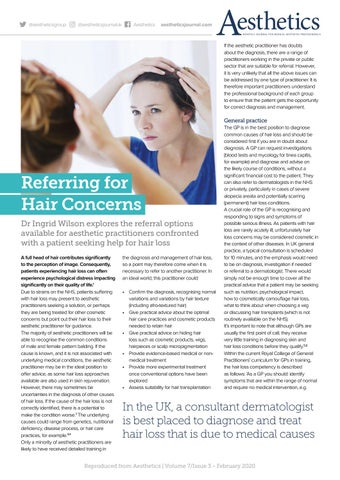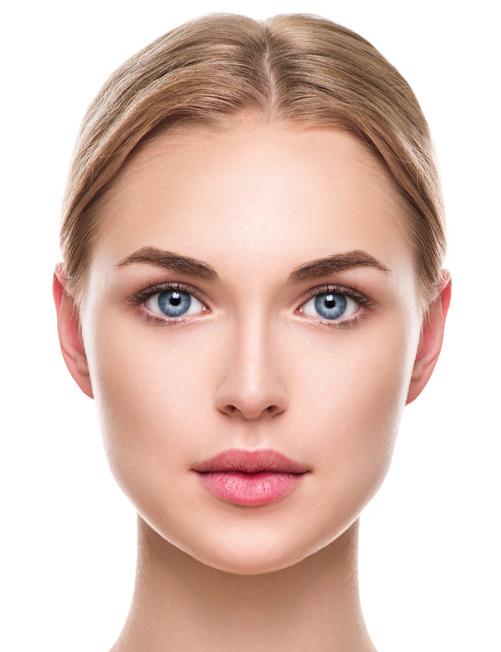@aestheticsgroup
@aestheticsjournaluk
Aesthetics
aestheticsjournal.com
If the aesthetic practitioner has doubts about the diagnosis, there are a range of practitioners working in the private or public sector that are suitable for referral. However, it is very unlikely that all the above issues can be addressed by one type of practitioner. It is therefore important practitioners understand the professional background of each group to ensure that the patient gets the opportunity for correct diagnosis and management.
General practice
Referring for Hair Concerns Dr Ingrid Wilson explores the referral options available for aesthetic practitioners confronted with a patient seeking help for hair loss A full head of hair contributes significantly to the perception of image. Consequently, patients experiencing hair loss can often experience psychological distress impacting significantly on their quality of life.1 Due to strains on the NHS, patients suffering with hair loss may present to aesthetic practitioners seeking a solution, or perhaps they are being treated for other cosmetic concerns but point out their hair loss to their aesthetic practitioner for guidance. The majority of aesthetic practitioners will be able to recognise the common conditions of male and female pattern balding. If the cause is known, and it is not associated with underlying medical conditions, the aesthetic practitioner may be in the ideal position to offer advice, as some hair loss approaches available are also used in skin rejuvenation. However, there may sometimes be uncertainties in the diagnosis of other causes of hair loss. If the cause of the hair loss is not correctly identified, there is a potential to make the condition worse.2 The underlying causes could range from genetics, nutritional deficiency, disease process, or hair care practices, for example.3,4 Only a minority of aesthetic practitioners are likely to have received detailed training in
the diagnosis and management of hair loss, so a point may therefore come when it is necessary to refer to another practitioner. In an ideal world, this practitioner could: • Confirm the diagnosis, recognising normal variations and variations by hair texture (including afro-textured hair) • Give practical advice about the optimal hair care practices and cosmetic products needed to retain hair • Give practical advice on hiding hair loss such as cosmetic products, wigs, hairpieces or scalp micropigmentation • Provide evidence-based medical or nonmedical treatment • Provide more experimental treatment once conventional options have been explored • Assess suitability for hair transplantation
The GP is in the best position to diagnose common causes of hair loss and should be considered first if you are in doubt about diagnosis. A GP can request investigations (blood tests and mycology for tinea capitis, for example) and diagnose and advise on the likely course of conditions, without a significant financial cost to the patient. They can also refer to dermatologists in the NHS or privately, particularly in cases of severe alopecia areata and potentially scarring (permanent) hair loss conditions. A crucial role of the GP is recognising and responding to signs and symptoms of possible serious illness. As patients with hair loss are rarely acutely ill, unfortunately hair loss concerns may be considered cosmetic in the context of other diseases. In UK general practice, a typical consultation is scheduled for 10 minutes, and the emphasis would need to be on diagnosis, investigation if needed or referral to a dermatologist. There would simply not be enough time to cover all the practical advice that a patient may be seeking such as nutrition, psychological impact, how to cosmetically camouflage hair loss, what to think about when choosing a wig or discussing hair transplants (which is not routinely available on the NHS). It’s important to note that although GPs are usually the first point of call, they receive very little training in diagnosing skin and hair loss conditions before they qualify.5,6 Within the current Royal College of General Practitioners’ curriculum for GPs in training, the hair loss competency is described as follows: ‘As a GP you should: identify symptoms that are within the range of normal and require no medical intervention, e.g.
In the UK, a consultant dermatologist is best placed to diagnose and treat hair loss that is due to medical causes
Reproduced from Aesthetics | Volume 7/Issue 3 - February 2020













